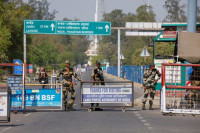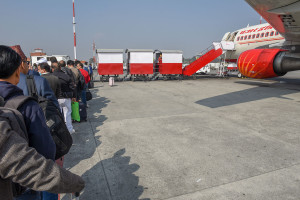Opinion
Looking east
A strategic marketing plan is needed to tap into the outbound Chinese tourism market
Saroj Dhakal
Outbound Chinese tourism is shaping the tourism industry as well as the global economy. In 2017, China Tourism Academy reported that Chinese people accounted for 130 million tourists and a total spending amount of $115 billion dollars. China will continue to be the largest international tourism market in terms of trips and spending, way ahead of the United States and Germany (which are currently the runner-ups). Chinese investments in hotels and tourism infrastructure will continue to grow, as investors follow their customers abroad while also targeting the wider tourism market in general. In an interview with Asia Pacific Daily [APD]’s Issue 57, Minister of Culture, Tourism and Civil Aviation, Rabindra Adhikari stated that, ‘In the first three months of 2018, China has topped as the tourist source market for Nepal for the first time. By 2020, we have a target to attract 500,000 tourists from China with a total estimate of about 2 million tourists.’ Given this ambitious goal, a targeted approach to tapping into this emerging market is necessary.
A diversifying market
According to 2017 China Outbound Travel Report published by CTRIP and China Tourism Academy, based on online bookings data, the 20 most popular destinations for Chinese travelers were Thailand, Japan, Singapore, Vietnam, Indonesia, Malaysia, Philippines, and the United States, among others. In first quarter of 2018, China became a top tourism source for Nepal as well. Less than 10 percent of China’s population travels overseas and only 10 percent owns a passport. This reflects huge potential for the outbound market. Shanghai, Beijing, Chengdu, Guangzhou and Shenzhen are unquestionably the four major exit ports of China. However, there are now new first-tier cities. All have seen great numbers in outbound travelers. In 2017, Chengdu ranked third in the number of outbound tourists (an increase of 75 percent). Shenzhen came in fifth place.
In the case of China inbound as well as outbound tourism are closely related to eastern coastal areas. Forty-one per cent of the total population is in these areas. Beijing, Shanghai and Guangdong alone account for two thirds of the revenue from inbound tourism and for half of all outbound travelers. The flight from Guangdong to Kathmandu is an estimated four hours and fifteen minutes. As per the data provided by Rajan Adhikari, Marketing Department of Asia Pacific Daily [APD], about 60 lakhs outbound tourists reside in Guangdong with their preferred destination of Guangdong in Macau and Hongkong.
In the context of Nepal, since China’s market for outbound tourism is rapidly growing, a flourishing business2business industry dominated by travel agencies and Chinese speaking guides has emerged as well. Furthermore, companies such as CTRIP have followed the Trivago model of business where agreements are signed with multiple travel agencies so that there is competition on price and more affordable costs for travellers. This is especially important for the ever-diversifying Chinese tourism market; Apart from official visitors, farmers, industrial workers and first time travelers also visit Nepal.
In 2014, Nepal received 123,805 Chinese visitors. China’s outbound tourism has a market share of about 17 percent to 20 percent. The Gorkha earthquakes of 2015 caused this number to fall to 66,984. But since then, the numbers have been rapidly recovering; in 2016, it rose to 80,553 and in 2017, it grew to more than 100,000.
Key challenges
The Visit Nepal 2020 strategy that aims to attract half a million tourists from China alone is a highly ambitious major policy initiative that may have certain shortcomings. Holidays are generally planned two to three years in advance. The fact that the strategy was announced during the end of the first quarter of 2018 by Finance Minister Khatiwada leaves little time for clearly targeted marketing and sales strategies. Even under the leadership of coordinator Suraj Vaidya, timeline will undoubtedly serve as a major limitation. More work also needs to be done to address other hurdles. Other obstacles include the lack of linguistically proficient guides, internal service delivery capacity of hotels, overall hospitality standards and service options. Furthermore, more could be done to harness the spending capacity of Chinese tourists. During an eight to ten day trip, the average spending of outbound Chinese tourists in Nepal—excluding flight tickets but including service and VAT—comes to around 400 to 500 dollars in Nepal. This is considerably low when compared to the spending patterns of Chinese tourists in other destinations.
With Visit Nepal 2020 in sight, Nepal needs to draw a three-year master plan for the marketing and promotion of Nepal in China in the top five outbound tourism or departure cities of China, namely Shanghai, Beijing, Chengdu, Guangdong and Shenzhen from 2019 to 2022. Furthermore, Nepal needs to also devise a strategic plan to draw tourists from the top ten cities with fastest growing number of outbound tourists namely Xi’an, Changsha Wuxi Taiyuan, Wuhan, Hefei, Chengdu, Nanjing, Harbin and Kunming. There are multiple stakeholders from both Nepal and China already working to expand the size of the outbound Chinese tourism market in Nepal—such as the Nepal China Tourism Promotion Society [NCTPS], Asia Pacific Daily [APD] and the Chinese C Center—that can directly assist the government in developing such a master plan. If the Government of Nepal seeks to increase its share in China’s outbound tourism market and grow its contribution to the national GDP, investing in a clear marketing and sales pan is a necessary prerequisite.
Dhakal is the CEO of 8848 Inc.




 13.12°C Kathmandu
13.12°C Kathmandu










